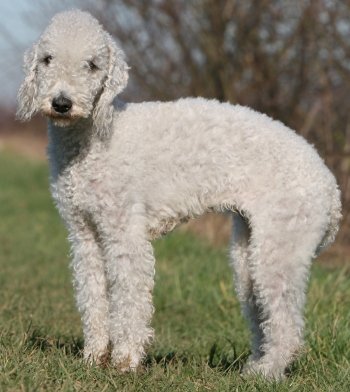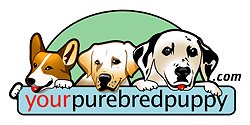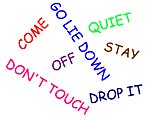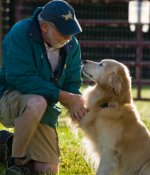Bedlington Terriers: What's Good About 'Em, What's Bad About 'Em
Bedlington Terrier temperament, personality, training, behavior, pros and cons, advice, and information, by Michele Welton, Dog Trainer, Behavioral Consultant, Author of 15 Dog Books

If all you're looking at is the elegant body and lamblike coat, you might be surprised to discover how athletic the Bedlington Terrier truly is.
Agile and graceful with a light, springy gait, the Bedlington Terrier needs access to a safe fenced area where he can play and dodge and gallop at the breathtaking speeds clearly suggested by his lithe build.
Although milder-mannered and less rowdy indoors than most other terriers, once outdoors and aroused, the Bedlington changes from docile couch potato to dauntless explorer.
Bright and clownish with his own family, his reaction to strangers varies from inquisitive to reserved; he needs early socialization so that caution does not become timidity.
Bedlington Terriers are generally peaceful with other pets, though some can be scrappy with strange dogs. With his terrier heritage, one should expect that running animals will be chased.
Bedlington Terriers can be stubborn, but do respond well to obedience training that is upbeat and includes lots of praise and food rewards.
This sensitive breed should not be handled harshly or jerked around, nor does he meekly accept being teased by children.
If you want a dog who...
- Is conveniently-sized – not too small and definitely not fragile
- Is unusual-looking – a distinctive "little lamb" appearance
- Is fast, agile, and graceful, with a light, springy gait
- Is not a heavy shedder
- Is less rowdy and calmer indoors than some other terriers
A Bedlington Terrier may be right for you.
If you don't want to deal with...
- The dynamic terrier temperament (see full description below)
- Providing enough exercise and activities to keep them busy
- Potential aggression toward other animals – chasing instincts
- Stubbornness
- Digging holes
- Barking
- Regular brushing, trimming, and clipping of the curly coat
A Bedlington Terrier may not be right for you.
 |
Dog Breed Traits – Which Traits Are Right For You? In this brand new series, I'll help you decide which dog breed traits would best suit you and your family, your home and yard, and your lifestyle, so you can choose the best dog breed for your family. |
Keep in mind that the inheritance of temperament is less predictable than the inheritance of physical traits such as size or shedding. Temperament and behavior are also shaped by raising and training.
FREE eBooks by Michele Welton
![]() "Respect Training for Puppies" and "Teach Your Dog 100 English Words" are free step by step guides to teaching your pup to be calm and well-behaved.
"Respect Training for Puppies" and "Teach Your Dog 100 English Words" are free step by step guides to teaching your pup to be calm and well-behaved.
![]() "11 Things You Must Do Right To Keep Your Dog Healthy and Happy" is a free guide to keeping your dog mentally, physically, and emotionally happy and healthy so you can enjoy a longer lifetime of companionship.
"11 Things You Must Do Right To Keep Your Dog Healthy and Happy" is a free guide to keeping your dog mentally, physically, and emotionally happy and healthy so you can enjoy a longer lifetime of companionship.

- You can avoid some negative traits by choosing an ADULT dog from an animal shelter or rescue group. With an adult dog, you can easily see what you're getting, and plenty of adult Bedlingtons have already proven themselves not to have negative characteristics.
- If you want a puppy, you can avoid some negative traits by choosing the right breeder and the right puppy.
More traits and characteristics of the Bedlington Terrier
If I was considering a Bedlington Terrier, I would be most concerned about...
- The dynamic terrier temperament. Most terrier breeds are remarkably similar. The same words are used over and over – quick to bark, quick to chase, lively, bossy, feisty, scrappy, clever, independent, stubborn, persistent, impulsive, intense. But some terrier breeds are more so than others. Overall, as a breed, Bedlington Terriers tend to be in the lower-to-middle section of the terrier spectrum. But of course there are some individual Bedlingtons who will be in the higher end!
- Providing enough exercise. Bedlingtons don't need miles of running but they are lithe little athletes who love to run at full speed. They need a large enough fenced yard to break into a gallop. Frequent trips to the dog park are recommended.
- Running away from you. Like all dogs, Bedlington Terriers must be taught to come when called. But I would only count on this breed obeying his training in an enclosed area. Bedlingtons should not be trusted off-leash. These dogs are runners, they are blazing fast, and the risk is too great that they will take off at full speed after anything that runs.
- Potential animal aggression. Bedlington Terriers are much less scrappy toward strange dogs than many other terrier breeds. But despite their soft lamb-ish look, they can be a determined force to reckon with if they decide to initiate or accept a challenge to fight. Because of their hunting heritage, some Bedlingtons have instincts to chase and seize small fleeing creatures. The family cat is usually fine, but not pet rodents.
- Potential barking. Terriers are often too quick to sound the alarm at every new sight and sound. You have to be equally quick to stop them.
- Independent temperament. Bedlington Terriers must be taught at an early age that they are not the rulers of the world. The toughness that makes them suited to killing vermin can frustrate you when you try to teach them things they don't see the point in learning.
To teach your terrier to listen to you, "Respect Training" is mandatory. Read my free online training programs.
- Potential defensive reactions. If you need to physically chastise a terrier, and you go beyond what THEY believe is a fair correction, terriers (as a group) are more likely than other breeds to growl or snap. As an obedience instructor, I'm always extra careful when putting my hands on a terrier for a correction.
I do not recommend terriers around small children. Many terriers will not tolerate any nonsense from little life forms whom they consider to be below themselves in importance. Many terriers are quick to react to teasing, and even to the normal clumsiness that comes with small children (accidental squeezing of their ears or pulling of whiskers or stepping on their paw). Many terriers are possessive of their food and toys and will defend these from all comers, including children.
- Grooming. Bedlington Terriers require a lot of coat care. Regular brushing, and also clipping and trimming every few months. Note that this breed is low-dander and light-shedding, but not NON-shedding. If you're allergic to dog dander or hair, you might be okay with a Bedlington. Or not. (A Poodle is the safest breed for allergic people.)
- Finding one. Very few Bedlington Terrier puppies are born each year, and very few adult Bedlingtons are available from rescue groups. You will need to get on a waiting list for either a puppy or an adult.
My best-selling books – now available FREE on my website
 Respect Training For Puppies: 30 seconds to a calm, polite, well-behaved puppy is for puppies 2 to 18 months old. Your puppy will learn the 21 skills that all family dogs need to know. Click here to read for free.
Respect Training For Puppies: 30 seconds to a calm, polite, well-behaved puppy is for puppies 2 to 18 months old. Your puppy will learn the 21 skills that all family dogs need to know. Click here to read for free. Teach Your Dog 100 English Words is a unique Vocabulary and Respect Training Program that will teach your adult dog to listen to you and do what you say. Click here to read for free.
Teach Your Dog 100 English Words is a unique Vocabulary and Respect Training Program that will teach your adult dog to listen to you and do what you say. Click here to read for free. 11 Things You Must Do Right To Keep Your Dog Healthy and Happy helps your dog live a longer, healthier life. Get my honest advice about all 11 Things before you bring home your new puppy, because some mistakes with early health care cannot be undone. Click here to read for free.
11 Things You Must Do Right To Keep Your Dog Healthy and Happy helps your dog live a longer, healthier life. Get my honest advice about all 11 Things before you bring home your new puppy, because some mistakes with early health care cannot be undone. Click here to read for free.Related posts you might enjoy






